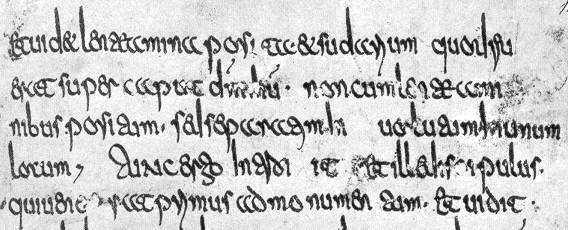Script Type : minuscule; a variant of Merovingian minuscule
Date : 7th and 8th centuries, disappeared with the destruction of the monastery of Luxueil in 732 by the Saracens
Location : France, especially associated with the monastery of Luxueil
Function : book hand

























The letter a is open at the top and looks like cc. The letter f is truly peculiar, while g is closed at the top but has a zigzag form to the descender. There are two forms of d, the upright and the rounded backsloping types, but the loop seems to become open in certain letter combinations. There are also two forms of n as a majuscule form is sometimes used. There are two forms of r, one of which is very pointed. The letter t is short and has a loop on its back. The letter i is extended in length when it appears at the beginning of a word. The letters u and v are identical. The rare letter y is dotted, although, as usual i is not.
There are no examples here of h, j, k, w or z.
For added confusion, there are many ligatures which can change the form of letters considerably. The letter e becomes raised at the top in such examples as
 en
en  er
er  et.
et.
The letter i develops a long descender in
 ri.
ri.
The letter t grows an elaborate double loop in
 te
te  ti
ti  tr
tr  tu.
tu.
There are few abbreviations in this sample, although examples of the nomina sacra appear.
One problem for decoding is that the word spacing is erratic, suggesting a painstaking process of copying in a difficult and mannered script with perhaps less than perfect comprehension.
Pass the cursor slowly over the first few lines to find out if what appears bears any relationship to what you were expecting. The transcription is from Steffens as it certainly gives me some trouble. For further details proceed to the paleography exercises.
Paleography
exercises for this example ![]()
Requires at least the Flash 5 plugin
If you are looking at this page without frames, there is more information about medieval writing to be found by going to the home page (framed) or the site map (no frames).